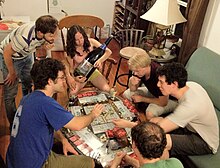RoboRally
RoboRally is a board game originally published in 1994 by Wizards of the Coast (WotC). It was designed in 1985 by Richard Garfield, who would later create the card game Magic: The Gathering. The game and its expansions received a total of four Origins Awards.RoboRally was rereleased in July 2005 under the Avalon Hill label, and again in 2016 by Wizards of the Coast.
In RoboRally, players assume control of one of many "Robot Control Computers" in a dangerous widget factory filled with moving, course-altering conveyor belts, metal-melting laser beams, bottomless pits, crushers, and a variety of other obstacles; the concept is that this is what the control computers do for fun after hours. The goal in a game of RoboRally is, apart from survival, to be the first to reach a pre-designated number of checkpoints in a particular order. However, the real difficulty in RoboRally is movement, which is accomplished with the randomly dealt program cards.
The program cards specify movement, such as move one space forward, turn left or U-turn. The cards have to be arranged by the player in the specific manner they wish the robot to move. Each player receives up to nine cards each turn. They use five of the cards to specify their robot's movement for the given turn, playing each card face down into one of five available "registers". All robots move simultaneously, each player revealing each register in turn. Robots attempting to move into the same space at the same time are resolved by priority numbers printed on the cards. A robot moving into an occupied space "pushes" the blocking robot (even more of them) into the next space. Players with damaged robots receive fewer cards: with one point of damage, the player receives eight cards, with two points, seven cards, and so on. When a player's robot takes five or more points of damage, its registers become "locked", keeping specific program cards in play until the robot is repaired. Each player has a very limited amount of time to place their cards, which combined with the unpredictability of the plans of the other players, often leads to one's robots moving in unexpected ways.
...
Wikipedia

